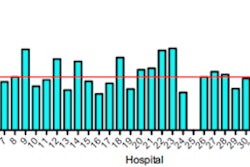With the launch last month of Radisphere National Radiology Group, a national provider of professional radiology services, some industry watchers wonder if companies like it will erode the radiologist-as-entrepreneur model and replace it with a radiologist-for-hire paradigm.
Others wonder, if these kinds of national radiology businesses proliferate, whether the shift will affect not only how radiologists pass on knowledge to residents, but also how they share knowledge with each other.
The type of radiology education that could be most affected by companies that contract directly with hospitals for radiology services (offering teleradiology not just for night reads but for anything), such as Beachwood, OH-based Radisphere or Santa Monica, CA-based Imaging Advantage, would probably be the education that happens in hospitals served by local radiology groups, according to first-year radiology resident Dr. David Karimeddini at Hartford Hospital in Hartford, CT.
"Our attendings are mentors," Karimeddini told AuntMinnie.com. "They work for a private group in our area and give us feedback on our interpretations. So if a hospital [like ours] decided to cut costs by hiring a virtual radiology group, how would the residents learn if there were fewer attendings -- or no attendings -- onsite? Electronic feedback has its limits."
And because the practice of radiology has expanded beyond a single radiologist sitting in front of a light box, there's more for residents to learn, according to Dr. Marcia Javitt, head of body MRI and genitourinary radiology at Walter Reed Army Medical Center in Washington, DC, and the American Journal of Roentgenology's section editor for women's imaging.
"[Established radiologists] have to educate residents in everything we do, plus teach them how to become part of a healthcare management team," Javitt said. "Now residents have to learn how to come out from behind the view box and take responsibility for a patient's care in a way that was never taught to [our generation]. And if radiologists don't do this, we're at risk of becoming replaceable."
Radisphere works primarily with community hospitals, so dealing with residents is less of an issue, according to Dr. Frank Seidelmann, one of Radisphere's founders and director of the company's neuroradiology section. But the company does put on its own internal educational webcast program twice a week, and those radiologists at academic institutions who want to include residents can do so.
And using remote tools for feedback works just fine, he said.
"We have a proprietary program that allows us to share cases with colleagues via workstations," Seidelmann told AuntMinnie.com. "I can log on to my workstation and interact with my peers in real time. It's something we do numerous times per day. People say [we can't be as effective because] we're remote, but I've never been closer to my colleagues and other experts than I am in this practice."
Does remote care affect quality?
A virtual radiology model that places fewer radiologists at a facility and uses remotely based radiologists for the bulk of service could also affect how peer radiologists perform, according to Dr. Giles Boland, vice chair of radiology at Massachusetts General Hospital in Boston.
"Radiologists who work 'virtually' don't belong to a hospital and may or may not get clinical feedback [on their work]," Boland said. "I think there's a challenge there on keeping up-to-date with the latest and greatest protocols, but also the daily clinical conversations that go on in a hospital environment -- the camaraderie, the ability to ask each other questions about cases, to share new equipment protocols. It would be up to them [the remote radiologists] to use their own self-discipline [to keep current]."
Could disconnect between remote radiologists and their on-the-ground counterparts cause patient care to suffer? It's a possibility, Boland said, especially because one of the most important issues in radiology is having transparent and reproducible quality assurance tools: If radiologists don't get feedback on errors, they can't learn from them.
"Given that for so much of the workday, radiologists are together or easily accessible, there's ease in knowledge transfer that helps us better care for patients," he said. "I've been a GI subspecialist for 20 years, and I still need help with cases sometimes."
There's so much that happens in a radiology department in addition to film interpretation, such as consultation among radiologists and participating in hospital and departmental operations, and working via remote means may not cut it, Javitt said.
"We talk to each other to get a consult. If that transaction has to be done remotely with automated or teleradiology tools, it's very different than standing there with someone you know and trust and asking them what they think about a case," she said. "It's great to have objective information, but it's not so great to have no human interaction."
But there is human interaction within the Radisphere model, Seidelmann said, and cross-pollination does happen.
"Our system is set up so I can get opinions on urgent cases as well as not-so-urgent ones and learn from others," he said. "Every day I'm learning, and hopefully helping my colleagues."
By Kate Madden Yee
AuntMinnie.com staff writer
May 25, 2010
Related Reading
Are hospitals playing hardball with radiology groups? April 22, 2010
Radisphere skirts local groups in bid for hospital contracts, April 15, 2010
Imaging Advantage creates uproar with new business model, July 9, 2009
Florida Hospital forms own radiology group, May 22, 2008
Teleradiology: A threat to local practices? April 22, 2008
Copyright © 2010 AuntMinnie.com



















